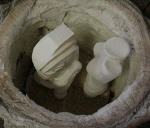 |
 |
||
| THE RAKU PROCEDURE |
||
| Getting started |
||
| Applying the glaze |
||
| Setting up the kiln |
||
| About the burner |
||
| Loading the kiln |
||
| The actual firing |
||
| Unloading the kiln |
||
| Temperature shock |
||
| Reduction |
||
LOADING THE KILN |
|||||
When you load the ware into the kiln it is important that you maintain sufficient clearances between the individual pieces but also to the side of the kiln. Prior to the moment that it flows out the glaze may bubble to a sort of foam layer like shaving foam. This phenomenon and the manner in which it occurs may vary with the glaze that you use. However you should avoid that two pieces of ware „kisses“ each other in this stage leaving a mark on both pieces, or that the insulation blanket is touched. |
|
||||
|
Printable Version |
|||||
